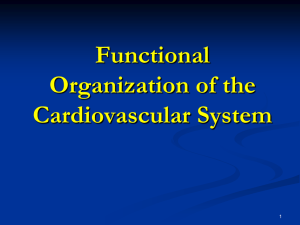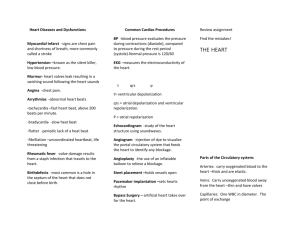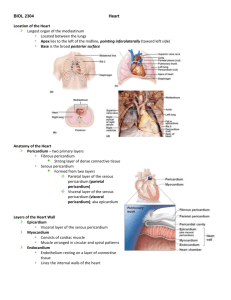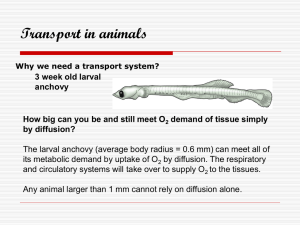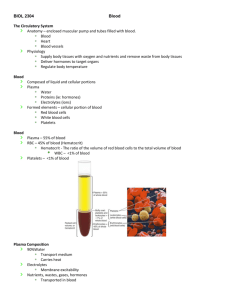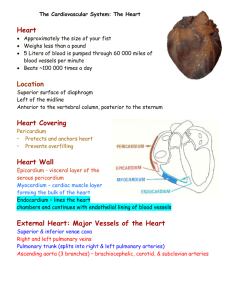Structure and function of the Cardiovascular System (CVS)
advertisement
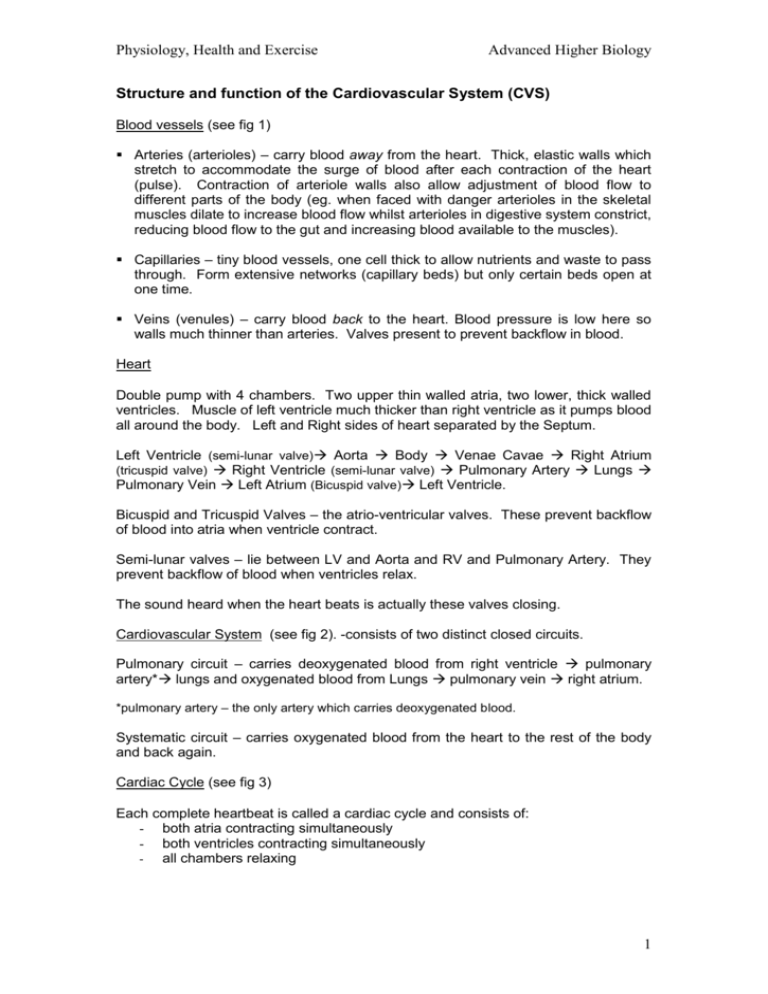
Physiology, Health and Exercise Advanced Higher Biology Structure and function of the Cardiovascular System (CVS) Blood vessels (see fig 1) Arteries (arterioles) – carry blood away from the heart. Thick, elastic walls which stretch to accommodate the surge of blood after each contraction of the heart (pulse). Contraction of arteriole walls also allow adjustment of blood flow to different parts of the body (eg. when faced with danger arterioles in the skeletal muscles dilate to increase blood flow whilst arterioles in digestive system constrict, reducing blood flow to the gut and increasing blood available to the muscles). Capillaries – tiny blood vessels, one cell thick to allow nutrients and waste to pass through. Form extensive networks (capillary beds) but only certain beds open at one time. Veins (venules) – carry blood back to the heart. Blood pressure is low here so walls much thinner than arteries. Valves present to prevent backflow in blood. Heart Double pump with 4 chambers. Two upper thin walled atria, two lower, thick walled ventricles. Muscle of left ventricle much thicker than right ventricle as it pumps blood all around the body. Left and Right sides of heart separated by the Septum. Left Ventricle (semi-lunar valve) Aorta Body Venae Cavae Right Atrium (tricuspid valve) Right Ventricle (semi-lunar valve) Pulmonary Artery Lungs Pulmonary Vein Left Atrium (Bicuspid valve) Left Ventricle. Bicuspid and Tricuspid Valves – the atrio-ventricular valves. These prevent backflow of blood into atria when ventricle contract. Semi-lunar valves – lie between LV and Aorta and RV and Pulmonary Artery. They prevent backflow of blood when ventricles relax. The sound heard when the heart beats is actually these valves closing. Cardiovascular System (see fig 2). -consists of two distinct closed circuits. Pulmonary circuit – carries deoxygenated blood from right ventricle pulmonary artery* lungs and oxygenated blood from Lungs pulmonary vein right atrium. *pulmonary artery – the only artery which carries deoxygenated blood. Systematic circuit – carries oxygenated blood from the heart to the rest of the body and back again. Cardiac Cycle (see fig 3) Each complete heartbeat is called a cardiac cycle and consists of: - both atria contracting simultaneously - both ventricles contracting simultaneously - all chambers relaxing 1 Physiology, Health and Exercise Advanced Higher Biology Two phases in cardiac cycle: - systole – contraction of the heart (atrial followed by ventricular contraction) - diastole – relaxation of the heart. Normal range for resting heart beat – 60-90 beats per minute (bpm). Each cardiac cycle lasts about 0.8 seconds (0.3 for systole; 0.5 for diastole). Cardiac Output (CO) – the volume of blood pumped by each ventricle per minute and is a function of two factors – heart rate and stroke volume. Heart rate (HR) = beats per minute and Stroke volume (SV) = volume of blood ejected by each ventricle during each contraction. CO = HR x SV Example: Person at rest HR = 72 beats/min SV= 70ml CO = 72 x 70 = 5040ml/min = 5 litres/min Cardiac output varies between individuals and depends on their physical fitness and levels of activity. A highly trained athelete can pump 30-35l/min while most nonathletes can only achieve a maximum cardiac output of about 20l/min. Heart rate can increase to a maximum of about 180-200 bpm (220 minus age in yrs). SV increases proportionally less (70-150ml). Therefore increase in cardiac output with exercise is achieved principally by increasing the heart rate. Blood Pressure: - the force exerted by the blood against the walls of the blood vessels. It is highest in the large elastic arteries, gradually dropping as it travels round the circulatory system and is almost zero by the time it gets returns to the right atrium. Low blood pressure in the capillaries allows the efficient exchange of substances between blood and the tissues (see fig 4). Arterial blood pressure is highest during ventricular contraction (systolic BP) and lowest during relaxation of the ventricles (diastolic BP), both of which can be measured using an inflatable instrument called a sphygmomanometer and a stethoscope (fig 5). - cuff inflated until pressure stops flow of blood through the artery - Air in cuff gradually released. When pressure in artery exceeds pressure in cuff the blood can be heard spurting through by stethoscope – this gives systolic BP value. - Cuff pressure continues to be reduced until the point where blood flow can no longer be heard – reading at this point gives you diastolic BP value. Pressure is measured in millimetres of mercury (mm Hg) and a typical reading for a young, healthy adult is about 120/70 mm Hg (SBP/DBP). Blood pressure varies considerable between individuals and fluctuates throughout the day. It tends to increase with age. Hypertension or High Blood Pressure is prolonged elevations of blood pressure and may increase to 300/120 mm Hg. Although it may go unnoticed for a while it ultimately puts excess strain on the heart and, if untreated, will lead to heart failure and death. REFERENCE: Andersen, F., 2000. Physiology, Health and Exercise. Student Monograph. Scottish CCC. 2



